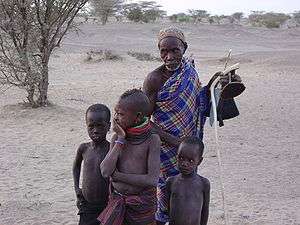Ateker peoples
 | |
| Regions with significant populations | |
|---|---|
| Kenya, Uganda | |
| Languages | |
| Karamajong, Turkana, Teso, Nyangatom, Toposa, Jie | |
| Religion | |
| African traditional religion, Christianity | |
| Related ethnic groups | |
| Other Nilotic peoples |
Ateker, or ŋaTekerin, is a common name for the closely related Jie, Karamojong, Turkana, Toposa, Nyangatom and Teso peoples and their languages.[1] These ethnic groups inhabit an area across Uganda and Kenya. Itung'a (a vernacular term meaning "people of one language")[2] and Teso have been used among ethnographers, while the term Teso-Turkana is sometimes used for the languages, which are of Eastern Nilotic stock. Ateker means 'clan' or 'tribe' in the Teso language. In the Lango language, the word for clan is atekere.
In the Turkana language, Ateker means a distinct group with related customs, laws and lifestyle and who share a common ancestry. Members of one Ateker have a common character of mutual respect for each other in their diversity. Each member group of Ateker occupies its own territory and exercises authority over its own land and people independent of each other.
The word Ateker is a generic term for "related peoples" or "relatives" (the term also refers to clan).[3] It is derived from the root ker, which has two root meanings: fear and respect. Ateker, in its true sense, is a union of free people with mutual recognition and respect for each other. In the context of ethnic identity and nationhood, the Turkana language classifies different people with common characteristics as belonging to distinct ateker. The Maa people belong to Ateker a Ngi Maasa Maasai and so on. The Turkana and the Karamojong and related people belong to one Ateker.
Common characteristics
Language
Member of one Ateker speak one language or distinct languages which developed from one common language.
Laws and customs
Each Ateker has distinct laws and customs. The laws and customs of people of one Ateker are similar.
Lifestyle
Members of each Ateker live their lives in a similar lifestyle. Diversified groups within one Ateker usually have traces of laws and customs that can be traced to the original group.
Land
Land is one characteristic that helps in determining membership in an Ateker. Members of one Ateker usually occupy adjoining areas. Land adjudication forms the basis for laws and customs. In the Turkana Ateker, land is subdivided into regions or territorial sections, ŋiTela. Each Ekitela institutes its own common laws which are derived from the general laws of the whole nation or kingdom.
Religion
Religious beliefs of one Ateker are similar. The supreme deity worshiped has one common name.
Common ancestry
Members of one Ateker have a common ancestral origin.
Ateker laws
Among members of the Turkana-Karimojong Ateker, it is prohibited to kill members of the same Ateker. Killing members of the same Ateker is like killing one's own brother. Other laws govern marriage Akuuta, divorce elakit or akilak, grazing Achok or akitwar etc.
References
- ↑ Rischkowsky, Barbara; Pilling, Dafydd (2007). The State of the World's Animal Genetic Resources for Food and Agriculture. Food & Agriculture Org. p. 410. ISBN 9789251057629.
- ↑ Webster, James Bertin (1973). The Iteso during the asonya. East African Pub. House. pp. xxi.
- ↑ Webster, James Bertin (1973). The Iteso during the asonya. East African Pub. House. p. 58.